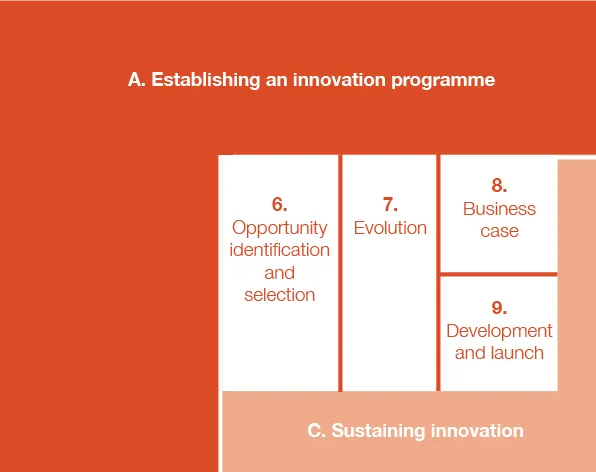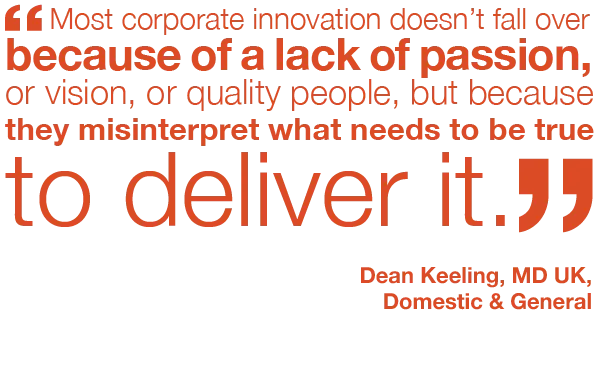![]()
Section B: Delivering Innovation Projects
Section A focused on establishing an overall programme of innovation in the right way and creating the environment for success. However, even if this has been done in the best possible way, there are still many obstacles for individual projects to overcome and sadly many companies focus on the wrong things when delivering individual innovation projects.
Once an idea has been chosen for development, the real hard work begins. A large amount of work is required to define the proposition in detail, research with customers, define the pricing, design the product or service, understand the operational delivery and supply chain, work out the sales and service approach, build the required IT changes and prototypes, create a marketing plan, develop the business case and trial or pilot the idea, and all of the above will need a number of iterations.
Much of the above is just hard work, attention to detail and an ability to retain focus on delivering the MVP. However, in the corporate environment, delivering innovation also means understanding the implications of the vision, what it is trying to achieve and the implications on the core business. If all of this is not recognised early on, it can create far greater obstacles.
Figure B.1 shows a modified version of the innovation framework diagram, with section B on delivering innovation projects broken down into its principal constituent areas.
Figure B.1: Innovation framework
The chapters of Part B discuss these sub-sections within delivering innovation.
![]()
6. Opportunity Identification and Selection
Focus on the customer problem, not the idea or the technology, to identify opportunities.
Understand the customer’s problem
Some companies have an idea and want to get it in front of customers quickly, but they do this before they have even talked to customers about the problem.
Rather than being randomly generated from a top-down strategy process or from blue sky brainstorming techniques, compelling ideas address a specific problem experienced by customers. This means that successful idea generation starts with deep insight into the customer segment, their behaviours and attitudes, and the exact nature of the problem and its context.
It sounds obvious that only when the problem is viewed with real clarity can the solution be delivered, and yet it is common to see corporate teams struggling to pin down the core of a proposition, simply because the problem they are trying to solve is not fully understood.
It is far easier to come up with ideas against a specific question than it is to generate ideas for a totally blank canvas. A clear problem statement is a great start point for generating ideas, but more importantly, those ideas will be resolving an important issue by definition, and hence are likely to be far more robust than blue sky thinking.
It is also important to make sure that the problem being focused on is worth solving for customers. A lot of issues may exist, but there are only a few that a customer is actually going to pay extra for, or switch suppliers to resolve.
Case example: Identifying the real problem – the brief
I was working on a soup project in the Netherlands, where they drink the stuff like we drink coffee. The project was looking at NPD on new varieties. We’d tried sweeter, stronger, thicker, more-exotic, less-exotic and fusion but none of it grabbed the attention of consumers plus we had some fears about cannibalisation. So we stopped the project.
We stepped back and found that actually the challenge was making sure that consumers had ready access to soup, so it suddenly became a channel project. We came up with a water boiler and proposition that turned every newsagent in the land into a vendor. It was wildly successful and opened around 3000 new outlets for the brand. People think of innovation as NPD, when in fact it’s about problem solving.
Meldrum Duncan, Co-Founder, Curious Industry
Case example: Clarifying the customer and commercial problem to innovate at BT
How do you grow the market in mature consumer telephony?
BT Answer 1571 was a spectacularly successful project but was still really hard to get over the line when it launched. Essentially, 40% of all call attempts ended in either no reply or the busy tone, which meant we were missing out on a lot of revenue and the customers were missing out on a lot of conversations.
So we came up with the idea of the 1571 service as a way of addressing it. The product line approached our technology supplier, who had actually already launched a similar product for Telefonica in Spain and they were able to give us lots of advice about the way to do it. The issue was around the commercials and the fear of cannibalization – the model was to offer it free and then charge the caller a minimum of 5p for the answering service. The finance community were worried that our 1.5 million paying voicemail customers would stop paying and just use this service and that we wouldn’t get to the 4 or 5 million customers that we need to make the business case stack up. I had to fight tooth and nail to get it launched, but eventually the Retail CEO got behind the idea and then it moved quickly. Once launched it blew our expectations and hit over 7m users and drove lots of revenue that wouldn’t have been there – effectively opening up that 40% of the market that wasn’t previously available and growing the market by turning non-calls into calls. It all happened because we dug into the problem and understood how we could solve it.
Ian Price, Former General Manager, Core Business, BT
Observe the real world first-hand to understand attitudes, behaviours and needs
One of the main factors that determines whether customer research is insightful is the extent to which it is combined with real-life observation. Getting a written response to a survey is obviously worse than speaking to a customer on the phone, which in itself is less informative than speaking with them face to face, when the researcher can get a much better sense of the answer as visual cues come into play. However, all of these pale in comparison to truly observing a customer’s practical behaviour.
Sometimes for an innovation to be successful it will require customers to change their normal behaviour, which can be immensely challenging. You may have the best product in the world but if it needs the customer to do something different to their normal routine – whether in buying or using it – it can be far harder to achieve success. This reality makes customer observation even more important, as it’s far easier to build a proposition that accounts for consumer behaviours if you fully understand them in the first place, as shown in the Procter & Gamble example earlier in the book.
So, the only way to achieve a real understanding of the problem is to get out of the building. Go and talk to customers, work with staff on the frontline, listen in on customer service calls, and spend time doing it to understand the context, the behaviours, the expectations, the attitudes and prejudices as well as just the stated needs. This does not mean asking a research agency to go and do it for you before handing you a report or video. It means you.
Some of us are more comfortable and interested than others in this, but the level of empathy and understanding that results is critical. Equally, it pays to think about how to involve key stakeholders and decision makers in this insight work too. If they understand the problem, then they are equally going to understand the answer. Ideally, that means involving them in the hands-on insight work as well, but if this isn’t possible then vox-pops, film recreations and even bringing customers in and putting them in front of senior executives can bring it to life instead.
Case example: Really understanding the problem for a consumer goods innovation
In one piece of research on floor cleaning, I was interviewing a woman in her home but was struggling to get to the heart of the matter. So I offered to wash her floor while she watched. She was horrified that I did it wrong and we then had a really insightful conversation about what was important in floor cleaning. Any idea generation process can work, if you have the right person. It’s not about val...


